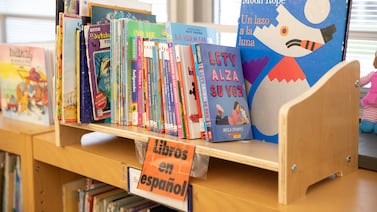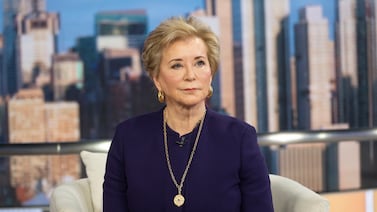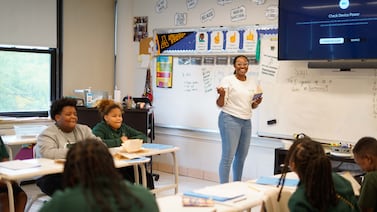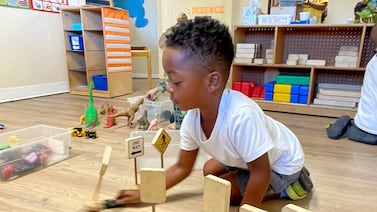Maria Barraza’s 8-year-old son spent half of first grade and all of second grade online because of the pandemic. When he started third grade this fall, Barraza was concerned. Her son’s writing and spelling were, in Barraza’s opinion, “way below,” and he couldn’t yet read on his own, which meant he struggled in math too because he couldn’t understand word problems.
She took him for an expensive private evaluation in September. The results of two days’ worth of tests confirmed what she suspected: He needed extra help in school. But Barraza said her repeated requests that her son receive special education services went unheeded for months.
“I’m confused as to what the battle is,” Barraza said. “What is the problem?”
Barraza isn’t alone. In Denver Public Schools, the number of initial evaluations for special education services for students ages 3 to 21 fell by about 35% from the 2018-19 school year to the pandemic-interrupted 2019-20 school year and remained low the following year.
Statewide, initial evaluations fell by about 16% and similarly have not recovered. That means 4,200 fewer children across Colorado were evaluated in 2019-20 than in 2018-19.
If children don’t get evaluated in a timely manner and start getting services, they can fall even further behind, lengthening the time it takes to catch up and affecting their self-esteem.
It’s not just a Colorado issue. Districts across the country, including Chicago and New York City, have experienced a decrease in students getting referred or evaluated for special education services, raising concerns that children with disabilities aren’t getting the help they need.
District administrators and special education teachers cite a host of challenges: staffing shortages, increased paperwork, new demands related to remote learning, and a hesitation to designate kids as having learning disabilities when they may be suffering the effects of remote learning and pandemic-related family trauma instead.
“We don’t want to leave a child behind if they need those [special education] services,” said Julie Rottier-Lukens, director of special education for the 90,000-student Denver Public Schools. “And yet we don’t want to make presumptions based on what we’re seeing in front of us right now and discount that kids have been through a lot.”
Parents say they’re sympathetic to the challenges, but their children shouldn’t pay the price.
No excuses
Elisa Aucancela, executive director El Grupo Vida, a local network of Latino parents of children with disabilities, said she feels schools sometimes use the pandemic as an excuse to wait to evaluate children who need more immediate help.
It’s especially frustrating when it happens to Spanish-speaking families whose children already have a diagnosis from a doctor, Aucancela said.
“When it’s a disability, it’s a disability,” she said.
Marta Edith Flamenco’s 4-year-old daughter has Dandy-Walker Syndrome, a congenital brain condition that affects the cerebellum and can cause developmental delays. Her daughter has received therapy through the county since she was born to help her eat, walk, and talk.
In 2020, when the girl was 3, Aucancela tried to refer the family for a school district special education evaluation so she could enroll in public preschool. But, citing a long waitlist, the district encouraged the family to enroll their daughter in preschool first and then do the evaluation, Aucancela said. Flamenco did that — but within two weeks, she said she was hit with a $550 preschool bill that her family couldn’t pay because her husband was out of work.
“The school was telling us we’d have to pay,” said Flamenco, who speaks only Spanish. “We stopped taking her because it was going to be too much.”
Denver charges tuition for preschool on a sliding scale, but students who qualify for special education services attend for free. As it is now, Flamenco’s daughter hasn’t been in school for more than a year. She cries because she wants to go back, her mother said.
“She used to be so happy and ready and she would share what she saw, what she learned, and she came [home] and she was ready to rest,” Flamenco said. “And now, she is so energetic. She’s just here, and she really wants to go to school. She has tantrums about it.”
Aucancela recently submitted another referral for special education services, and Flamenco said her daughter now has an appointment in March to get evaluated. Aucancela is pleased, but she said it’s troubling that it took so long for the family to get what they needed.
“The pandemic is here,” Aucancela said. But, she added, “we cannot use the pandemic as an excuse and just wait and wait and wait until the child is three years behind.”
Stretched thin
Meanwhile, special educators are “overloaded and overworked and overwhelmed,” said Hillary Daniels, a special education teacher at Denver’s Hallett Academy elementary school.
When the pandemic hit in March 2020 and schools shut down, special education evaluations came to a halt. Teachers had no real guidance for how to teach online, let alone conduct the type of tests needed to identify a student for special education. The district may consider evaluations done by outside providers, like the one Barraza obtained for her son, but they aren’t obligated to accept them when making decisions, a district spokesperson said.
The evaluations the district would have conducted in spring 2020 got pushed to the fall — and though officials came up with guidelines for how to do them virtually, it wasn’t easy, said Rob Gould, president of the Denver Classroom Teachers Association and a former special educator.
“It’s really hard to tell through a computer screen: Is this a learning disability? Is this an emotional disability? Or is this frustration because they can’t hear the teacher?” he said.
The setting presented challenges too. Before the pandemic, when Daniels would evaluate a student, it was she and the student in a quiet room at school. At home, she said, a student may be in a virtual evaluation while their sister is yelling in the background or horns are honking outside.
That meant that even if educators completed a virtual evaluation, it might not be accurate. Daniels recalls one student who, when school buildings reopened and he returned for in-person learning, did not match the individualized education program, or IEP, based on his virtual evaluation. The goals listed in his IEP focused on paying attention, staying on task, and improving his speech. When he got to school, his teachers realized he couldn’t yet hold a pencil — an important skill that was hard to evaluate online and had been completely missed.
“This child comes to us, and the needs he demonstrates in front of us in person are much different than the paper we got that tried to explain this child,” Daniels said.
In that case, the student had to be re-evaluated for motor skills and cognitive concerns, Daniels said. Such unexpected re-evaluations, when added to the regular flow of initial evaluations, planned re-evaluations, and annual IEP reviews, put special educators behind.
The data reflects that. Per federal law, districts must complete evaluations within 60 days from when a student’s parents give consent. Whereas Denver Public Schools completed 93% of initial evaluations for students ages 3 through 21 within 60 days in pre-pandemic 2018-19, that percentage dropped to 87% in 2019-20 and 84% last school year, according to state data.
On top of doing evaluations, the district asked special educators to write contingency plans that spelled out how each child would receive their services during virtual learning. Later, the district asked educators to review if the services each student received virtually were adequate or if the student qualified for makeup services because they missed so much.
Rottier-Lukens, Denver’s special education director, said the decisions were based on equity. For example, rather than wait for savvy parents to ask for the makeup services, officially known as compensatory services, the district is reviewing each child’s case proactively. But she acknowledged that doing so takes time and has contributed to a feeling among special education teachers and specialists of “being pulled right, left, and center.”
Daniels knows that feeling well. Whereas some special education teachers or specialists may be forced to spend less time working directly with students to complete what Gould called a “tsunami of paperwork,” Daniels has ended up taking her paperwork home.
“My work-life balance does not exist,” she said.
Short staffed
Staffing shortages have also contributed to the problem. It was difficult for districts to fill special education positions before the pandemic, but officials said it’s even tougher now. Denver Public Schools had 19 unfilled special education teacher positions and 118 unfilled special education paraprofessional positions as of January.
Rottier-Lukens said she’s also seeing more mid-year resignations than ever before.
“Typically, most teachers will fulfill their contract at least,” she said. “They’ll make it somehow to the end of the year. I’m seeing a lot more people just resigning in October.”
Because of all these factors, some advocates said they’re treading lightly when it comes to raising the alarm about delayed special education evaluations. Asked about the potential effects the situation is having on students, Gould, the union head, circled back to staffing.
“The effect is students may or may not have an instructor,” he said. “Everybody is at a breaking point now. I’m worried people will choose a different profession other than this.”
Barraza, who has spent months fighting for her 8-year-old son to get an evaluation, doesn’t pin any blame on teachers, who she said are expected to do too much. She’s experienced the fallout firsthand: Her son’s third-grade teacher quit last semester, citing mental anguish.
But Barraza’s compassion doesn’t mean she’s less adamant about getting her son the services and accommodations he needs to succeed in school. She said she knows they exist.
“That’s all I would like,” she said.







